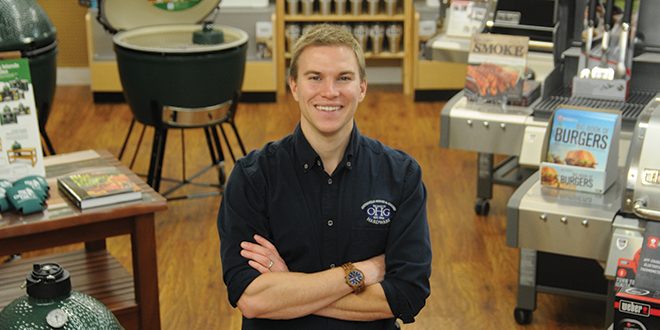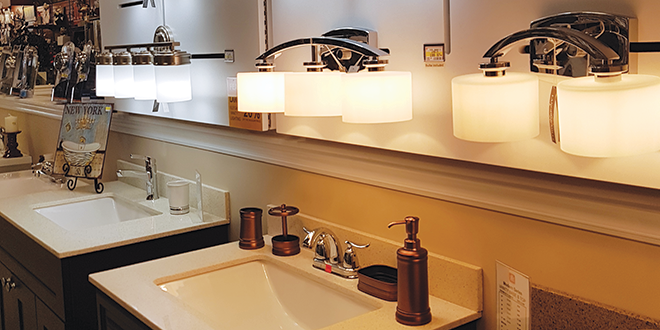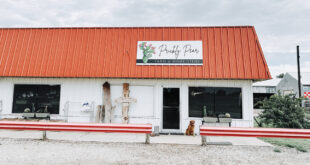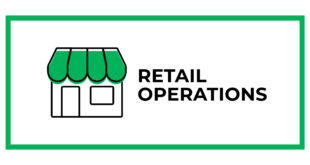Click the image above to view a full PDF.
Many entrepreneurs setting out to buy a business look for one that’s healthy, where risks are minimal and the probability for success is high. It’s a good, safe bet few would argue against.
Then there are those of a different breed who crave a challenge. They are able to see beyond the near-term shortcomings of a business to its long-term potential. And then they’re ready to take that risk head-on.
James Coté, owner of Osterville House & Garden in Osterville, Massachusetts, and Ron Cicuttini, owner of
four home improvement stores in Ontario, Canada, are two such retailers. They each purchased retail locations on the verge of oblivion and led the transformation to successful businesses. These stories are worth retelling. Not only are they inspiring, but by analyzing why a business failed, you can recognize possible weaknesses in your own operation and uncover clues on how to fix them.
A Second Chance for Osterville House & Garden

James Coté had just returned from college and was ready to resume his job at the town’s hardware store, but it was obvious that something was wrong. The store, sitting on the town’s picturesque main street, had once been busy with customers. Now, it was anything but attractive. The shelves were half-empty and many customers were leaving the store without purchasing anything. During a rainstorm, tarps covered several rows of gondolas so water from the leaking roof wouldn’t ruin merchandise. The building was on the verge of foreclosure.
Causes for the decline were easy to spot. The housing crash of 2008 struck a hard blow to the local economy. The owner, hoping the downturn would be short lived, tried to hold on to the property by selling off inventory. Purchases declined, and expenses overtook income. The business was quickly becoming unsustainable.
With a fresh business degree in hand, Coté might have gone anywhere to start his career. “But I was having a conversation with a customer about the store, how it might close soon, and he said, ‘You should buy the place,’” Coté recalls.
That conversation planted a seed in his mind. He talked it over with Megan, who is now his wife.
“She was on board with the plan, so we took the leap of faith,” he says. “Two months later, the store was ours.”
The Long Road Forward
Coté admits there were a lot of unknowns about how he could turn the business around, but he knew the issues the store was facing and what was working in his favor. Inventory was low, customers were frustrated and the building needed an overhaul, but the economy was starting to pick up again.
“Looking at past sales numbers, I knew there was potential,” he says. “My main effort was to bring in the inventory to bring in the customers.”
The other piece working in his favor was a strong support system. Megan helped out at the store on the weekends. He also kept the manager who had been at the store for 14 years. “That first winter, the manager and myself were the only full-time employees,” Coté says. “Without him, it would have been incredibly difficult.”
To finance the operation, Coté borrowed money from his parents, but cash flow was still tight. For the first nine months, he didn’t take a paycheck so he could put as many resources as possible into the store.
The first order of business was to start filling shelves and bring back those best-selling A and B items, which were often missing. Then, working with his wholesaler, Coté began sorting through planograms and assortments to make sure categories were complete. He also took advantage of dating opportunities when buying products and special buys he found at markets— anything that would help him stretch his dollars to regain momentum.
Another project was to work through the store’s inventory system to clear out dead items and get a correct account of everything he had. “We discovered about $30,000 worth of items that were not in our store but were on the records,” he says. “There were some inventory controls we needed to get back in line.”
Next, he began tackling the store’s layout. A cash register near the front of the store meant any customers waiting to cash out would be blocking the entrance. Coté relocated that service counter to open up the front of the store and chose that area to merchandise housewares. High-end housewares, he discovered, were popular with his customer base. Other cosmetic work gave the store a brighter, more inviting appearance.
Reestablishing the Community’s Trust
Bringing a failing store back to life isn’t just about getting the numbers back to where they should be. In most cases, the other half of the battle is restoring the community’s trust. Coté needed to convince customers who may have decided to stay away to come back.
“Almost immediately, I set up a Facebook page for the store and started using that to talk about the changes and promote the products we were getting in,” he says.
Soon after that, he bought a few ad spots on the local radio station, which were instantly well received. He also developed a website, a first for the store. The most effective changes, however, needed to go deeper than a few radio spots or Facebook posts. Presenting a new brand to the community would help him put a new face on the store. It was a not-so-subtle way of announcing that a new store ownership was making a fresh start.
Coté started a process of redesigning the store’s logo, keeping the existing name but presenting it in a new way. He also developed store uniforms and began selling logo wear to the community. All of those pieces working together helped give Osterville House & Garden a new reputation.
“People in the community were beginning to see we were making changes,” he says. “But having a new logo was a way to set ourselves apart from our checkered history. When we put the new sign out front and employees started wearing uniforms, I think it started to sink in for customers that the change was real. They didn’t just get lucky when they visited us and found what they needed—they could rely on us once more.”
Coté also got heavily involved in his local community. He took a seat on the town council and became involved in several community improvement projects. That public life gave him the opportunity to serve and give back his resources, but also showed he and his business were serious about being a part of the local community. In 2014, he was honored as one of NRHA’s Young Retailers of the Year.
Seven years later, the numbers show that all of that hard work paid off. At the end of 2010, when he purchased the business, Coté’s annual sales were less than $600,000 for his 7,500-square-foot store. Now, annual sales top $1.2 million.
Back from the Brink at Brantford Home Hardware

Brantford Home Hardware seemed to have a lot going its way. The economy around Brantford, Ontario, was strong and growing. Inside the store, the staff included a few key employees who were hard working with a strong capacity to lead. However, the business was on the verge of bankruptcy. There weren’t many customers coming in the doors.
That caught the attention of Ron Cicuttini. His experience in hardware retailing dates back to 1970 when he started working in the family business. Since then, he had run his own business successfully while staying alert for new opportunities, and Brantford Home Hardware was one he couldn’t pass up.
“I liked the store and the market it was in,” he says. “The business had a history of being successful, and there were also a lot of good people working there. That was one of the big reasons I ended up deciding to invest in it.”
So why was the business failing? Poor management, Cicuttini says. The previous owner stopped putting money into the business. Inside the store was a mishmash of products no one wanted. The owner ran out of money to buy inventory, and that resulted in a downward spiral. No one was coming in the store anymore because there was nothing to buy.
Taking ownership of the store would mean taking corrective action and making dramatic changes. Since reworking Brantford Home Hardware and making it profitable again, Cicuttini purchased another business facing a comparable situation. He’s found that the steps he took at Brantford are fairly similar to those he took at that other location as he set it on the road to profitability. In 2012,
he was honored as one of NRHA’s Top Guns for his contributions to the home improvement industry.
Making Sense of the Market
Cicuttini could clearly see the main problem at Brantford Home Hardware—poor product selection and low inventory. But to correct it would take more than just refilling pegs. Deeper changes were likely needed. Customers may not be buying because the product selection didn’t fit their needs. It was time to rethink assortments and categories across the store.
“The first thing I did was to get an in-depth market study done that shows critical information such as demographics of the area and estimated dollars spent by category,” he says. The market study, conducted by his supplier, showed he needed to adjust product selection in some categories and add new ones.
For example, the study showed the area had a big appetite for grills, but the store had very few outdoor barbeque items to offer. Cicuttini brought in new product lines and repositioned the category to be a grill destination. “We really analyzed what people were purchasing the most in our market, and then became strong in those areas,” he says.
Another major change in the product selection was a greater emphasis on fashion items, such as faucets, showerheads, vanities and lighting. He expanded assortments to include more options and displayed them in a more prominent area of the store so customers could easily see what was available. Part of the strategy, he says, was an attempt to make it more appealing to female shoppers. Stocking more fashion-oriented items also meant he could market his store as a project destination where DIYers would be more likely to make larger purchases, rather than just being a convenience hardware store.
Creating a Business Plan
After the market study was finished and he had analyzed the results, Cicuttini finished setting up the document that would help him set his direction for the coming months—his business plan. The business plan, he says, was the most indispensable tool he had as he began to plot the store’s path to profitability.
To make sure he stuck to that plan, it was important to refer frequently to financial statements, such as the income statement and balance sheet, to monitor the health of the business.
“When you’re taking over a store that’s been in financial trouble, it’s important to have your finger on those numbers on an almost daily basis to make sure you’re not sliding backward but always heading in the right direction,” he says.
If you only look at a business plan or refer to those key indicators every few months, he warns, you can quickly fall out of line and into a hole that’s difficult to escape. Instead, know the key indicators such as margins and sales that will alert you to the health of your business, and refer to them regularly. Then, when you spot a problem, you can react quickly and make the necessary adjustments.
As Cicuttini was using the market study to determine the best product selection for Brantford Home Hardware, he was also making another important discovery. The store layout was more of a hindrance than a help to shoppers. Endcaps were underutilized, lighting was poor and customers had a difficult time finding what they needed.
To fix it, he also changed the layout so it was easier for customers to locate products. The store has two power aisles, which gave him a lot of space for endcaps. He established a schedule of regularly rotating endcaps so customers would always have something new to see.
“It really looked like a brand new store when we finished with it,” he says. “We found that with the emphasis on good merchandising, people would stay longer, look around more and come back more often. By maintaining our endcaps, we found customers would come in on a weekly basis just to see what was new.”
 Hardware Retailing The Industry's Source for Insights and Information
Hardware Retailing The Industry's Source for Insights and Information









